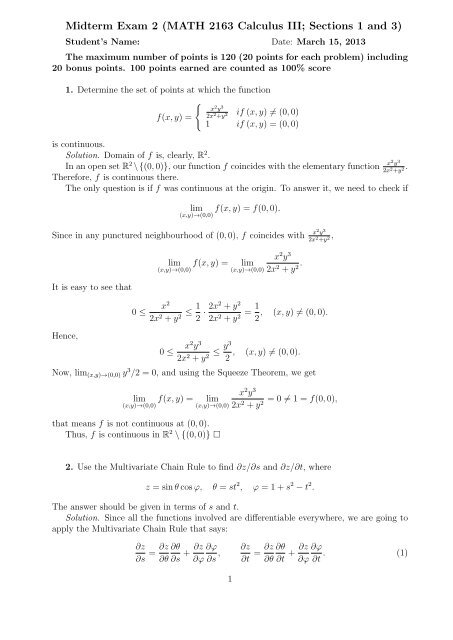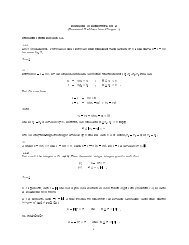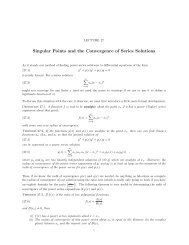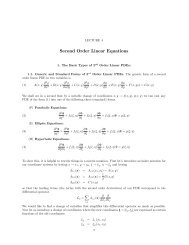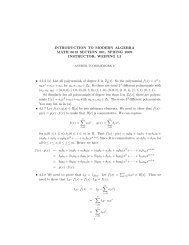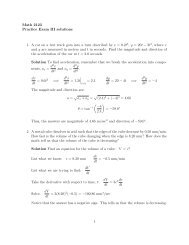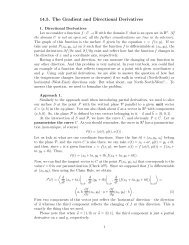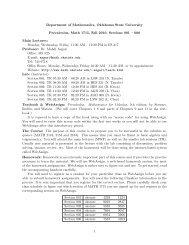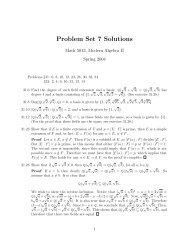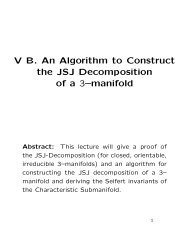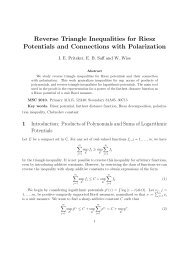Midterm Exam 2 (MATH 2163 Calculus III; Sections 1 and 3)
Midterm Exam 2 (MATH 2163 Calculus III; Sections 1 and 3)
Midterm Exam 2 (MATH 2163 Calculus III; Sections 1 and 3)
You also want an ePaper? Increase the reach of your titles
YUMPU automatically turns print PDFs into web optimized ePapers that Google loves.
<strong>Midterm</strong> <strong>Exam</strong> 2 (<strong>MATH</strong> <strong>2163</strong> <strong>Calculus</strong> <strong>III</strong>; <strong>Sections</strong> 1 <strong>and</strong> 3)Student’s Name: Date: March 15, 2013The maximum number of points is 120 (20 points for each problem) including20 bonus points. 100 points earned are counted as 100% score1. Determine the set of points at which the function{x 2 y 3if (x, y) ≠ (0, 0)f(x, y) = 2x 2 +y 21 if (x, y) = (0, 0)is continuous.Solution. Domain of f is, clearly, R 2 .In an open set R 2 \{(0, 0)}, our function f coincides with the elementary function x2 y 3.2x 2 +y 2Therefore, f is continuous there.The only question is if f was continuous at the origin. To answer it, we need to check iflim f(x, y) = f(0, 0).(x,y)→(0,0)Since in any punctured neighbourhood of (0, 0), f coincides with x2 y 32x 2 +y 2 ,It is easy to see thatHence,0 ≤lim f(x, y) =(x,y)→(0,0)lim(x,y)→(0,0)x 2 y 32x 2 + y 2 .x 22x 2 + y ≤ 1 2 2 · 2x2 + y 22x 2 + y = 1 , (x, y) ≠ (0, 0).2 20 ≤ x2 y 32x 2 + y ≤ y3, (x, y) ≠ (0, 0).2 2Now, lim (x,y)→(0,0) y 3 /2 = 0, <strong>and</strong> using the Squeeze Theorem, we getlim f(x, y) =(x,y)→(0,0)lim(x,y)→(0,0)that means f is not continuous at (0, 0).Thus, f is continuous in R 2 \ {(0, 0)} □x 2 y 3= 0 ≠ 1 = f(0, 0),2x 2 + y2 2. Use the Multivariate Chain Rule to find ∂z/∂s <strong>and</strong> ∂z/∂t, wherez = sin θ cos φ, θ = st 2 , φ = 1 + s 2 − t 2 .The answer should be given in terms of s <strong>and</strong> t.Solution. Since all the functions involved are differentiable everywhere, we are going toapply the Multivariate Chain Rule that says:∂z∂s = ∂z ∂θ∂θ ∂s + ∂z ∂φ∂φ ∂s ,∂z∂t = ∂z ∂θ∂θ ∂t + ∂z ∂φ∂φ ∂t . (1)1
Now,∂z∂θ = cos θ cos φ = cos ( st 2) cos ( 1 + s 2 − t 2) ,∂z∂φ = − sin θ sin φ = − sin ( st 2) sin ( 1 + s 2 − t 2) ,∂θ∂s = ∂θt2 ,∂t = 2st,∂φ∂s = 2s, ∂φ∂t = −2t.Finally, we need to put these expressions into (1), <strong>and</strong> get□∂z∂s = t2 cos ( st 2) cos ( 1 + s 2 − t 2) − 2s sin ( st 2) sin ( 1 + s 2 − t 2) ,∂z∂t = 2st cos ( st 2) cos ( 1 + s 2 − t 2) + 2t sin ( st 2) sin ( 1 + s 2 − t 2) .3. Find the directional derivative of the functionf(x, y, z) = ln ( x 2 + y 2) + √ xyzat the point (−1, 2, −2) in the direction of the vector ⃗v = ⟨−3, 0, 4⟩.Solution. The domain of our function f isD = { (x, y, z) : x 2 + y 2 ≠ 0, xyz ≥ 0 } .The point (−1, 2, −2) belongs to the interior of D since, for this point, x 2 + y 2 > 0 <strong>and</strong>xyz > 0.To get the directional derivative, we need the gradient vector of f at the given point.Hence,∂f∂x (−1, 2, −2) = −7 5 ,∂f∂x =∂f∂y =2xx 2 + y 2 +2yx 2 + y 2 +∂f∂z =xy2 √ xyz .1yz2 √ xyz ,xz2 √ xyz ,∂f13(−1, 2, −2) =∂y 10 , ∂f∂z (−1, 2, −2) = −1 2 .So, ∇f(−1, ⃗ 2, −2) = ⟨ − 7, 13,− 1 5 10 2⟩.The vector ⃗v is not unit. Therefore, to apply the formula for the directional derivative,we need to find the unit vector at the direction of ⃗v. Thus, lettoo)!1 Note:⃗u = ⃗v⟨|⃗v| = < −3, 0, 4 >√(−3)2 + 0 2 + 4 = − 32 5 , 0, 4 5xy√ xyzis not the same as √ xy√ z. Just compare the domains of both expressions (<strong>and</strong> possible values,2⟩.
Then,□D ⃗v f(−1, 2, −2) = ⃗ ∇f(−1, 2, −2) · ⃗u = 2125 + 0 − 4 10 = 2250 = 1125 .4. Find an equation of the tangent plane to the surface x 2 − 2y 2 + z 2 + yz = 2 at thepoint (2, 1, −1).Solution. First of all, let us notice that the point (2, 1, −1) belongs to the surface, so, wecan proceed.Our surface could be written in the form of F (x, y, z) = 0 withF (x, y, z) := x 2 − 2y 2 + z 2 + yz − 2.Function F is differentiable everywhere (it is just a polynomial in x, y <strong>and</strong> z). Therefore,the tangent plane at (2, 1, −1) exists, <strong>and</strong> its normal vector is ⃗ ∇F (2, 1, −1). So, we need toevaluate partial derivatives.∂F∂x = 2x,∂F(2, 1, −1) = 4,∂x∂F∂y∂F∂z= −4y + z,∂F= 2z + y,∂F(2, 1, −1) = −5,∂y(2, 1, −1) = −1.∂zHence, ⃗ ∇F (2, 1, −1) = ⟨4, −5, −1⟩. Now, we have a normal vector <strong>and</strong> a point on the plane.Thus, the equation of the tangent plane is4(x − 2) − 5(y − 1) − 1(z + 1) = 0,or4x − 5y − z − 4 = 0.□5. Find the points of local maximum, local minimum, <strong>and</strong> saddle points of the functionf(x, y) = x 3 + y 3 + 3xy.Solution. Our function is a polynomial in x <strong>and</strong> y, so, its domain is R 2 . Critical point arethose where all the partial derivatives that exist are equal to zero. The partial derivatives∂f∂x = 3x2 + 3y,∂f∂y = 3y2 + 3x,exist everywhere, whence the only possibility for a critical point is when both partial derivativesare equal to zero. Thus, we arrive at the system{ ∂f= 0, {∂x 3x 2 + 3y = 0,∂f= 0 3y 2 + 3x = 0∂y{ y = −x 2 ,y 2 + x = 0{ y = −x 2 ,x 4 + x = 0.3
The second equation can be factored as x (x 3 + 1) = 0 that has two solutions: x = 0, <strong>and</strong>x = −1. Thus, our system splits into two systems:{ y = 0,x = 0or{ y = −1,x = −1.Hence, we have two critical points: (0, 0), <strong>and</strong> (−1, −1).Now, we need to classify them, i.e., to decide what kind of extremum we have at eachof them, or may be we have saddle point(s). To do this, we may try the Second DerivativeTest.∂ 2 f∂x 2 = 6x,∂ 2 f∂y 2 = 6y,∂ 2 f∂x∂y = ∂2 f∂y∂x = 3.All the second order partial derivatives are continuous everywhere, so, we may apply theSecond Derivative Test. We need to consider the main minors of the matrix(∂ 2 f∂x 2∂ 2 f∂x∂yat each of the critical points.At (0, 0): ( 0 33 0)∂ 2 f∂x∂y∂ 2 f∂y 2).So, ∆ 2 = −9 < 0 implies that (0, 0) is a saddle point.At (−1, −1): ( ) −6 3.3 −6So, ∆ 1 = −6 < 0, ∆ 2 = 27 > 0 imply that (−1, −1) is a point of strict local maximum.□6. Evaluate the iterated integral0∫ 1 ∫ 200(x − y) 5 dy dx.Solution. We need to integrate ’from inside out’. So, we are integrating on y first:∫ 2] y=2(x − y) 5 (x − y)6 (x − 2)6dy =[− = − + x666 6 .Here, we considered x as a parameter, <strong>and</strong> used the substitution x−y = t (whence, dy = −dt)to find the anti-derivative.Now, we need to put the obtained expression to the ’outer’ integral, <strong>and</strong> integrate on xover the segment [0, 1]:∫ 1 ∫ 2∫ 1)(x − y) 5 (x − 2)6dy dx =(− + x6dx6 6□000y=0= 1 [−(x − 2) 7 + x 7] x=16 · 7= 1 ( )x=0 1 + 1 + (−2)7= −12642424= −3.


